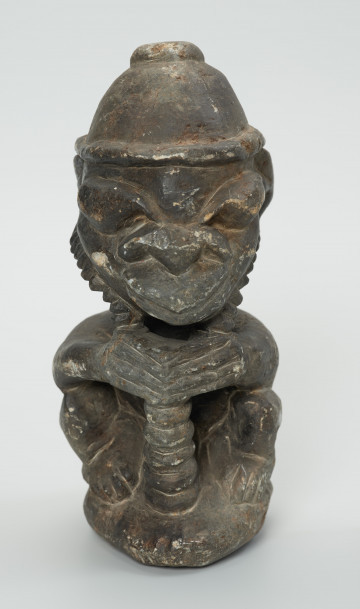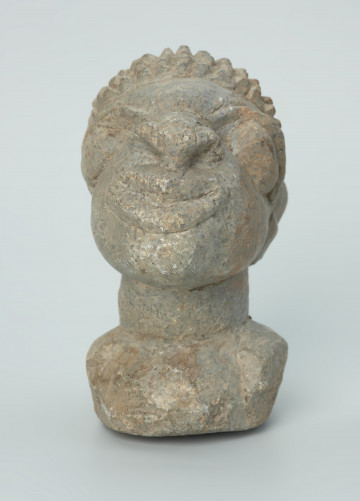
Figure of worship of forces of vegetation
1901 — 1971
National Museum in Szczecin
Part of the collection: Stone figurines from West Africa
Steatite figures found in south-eastern Sierra Leone near the Atlantic coast are known by the term taken from the Mende language nomolisia (singular nomoli). These sculptures are rare in Polish museums. The purpose of their creation remains unclear to this day. It is difficult to determine their age and the ethnic group which made them.The discussed nomoli sculpture shows an anthropomorphic figure in a sitting position, embraced from behind by a zoomorphic figure of the same size, most probably a lizard. Many nomolisia figures are presented in the company of animals, for example, as a rider riding a horse, elephant or leopard. Horses have always been scarce in this region, with historical data reporting isolated instances of horse ownership. In contrast, there is no record of elephants being used in West Africa, let alone cat-like animals. Undoubtedly, the depiction of a rider on an elephant, horse or leopard has metaphorical significance. The elephant is regarded in Sierra Leone as a symbol of the king's strength, while the leopard represents his power to dispense justice, showing that he can protect his people from the aggression of enemies. Nomolisia on which we see a human figure riding an animal or adorned with jewellery or weapons suggest that these may have been representations of figures endowed with worship, glory or dignity. They are signs of a person occupying a high social position. It is highly likely that originally nomolisia depicted deceased persons of high rank, such as village chiefs or other notables.
Katarzyna Findlik-Gawron
Author / creator
Dimensions
cały obiekt: height: 31,1 cm, width: 11,8 cm
Object type
figure
Creation time / dating
Creation / finding place
Identification number
Location / status

1901 — 1971
National Museum in Szczecin

1901 — 1971
National Museum in Szczecin

około 1970 — 1979
National Museum in Szczecin
DISCOVER this TOPIC
Museum of King Jan III's Palace at Wilanów
DISCOVER this PATH
Educational path